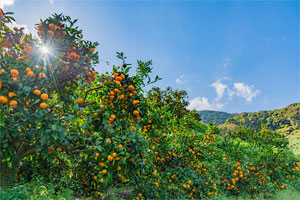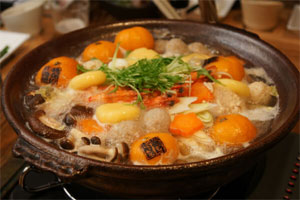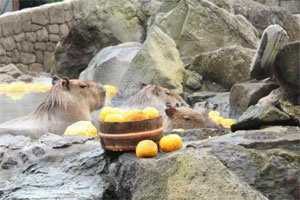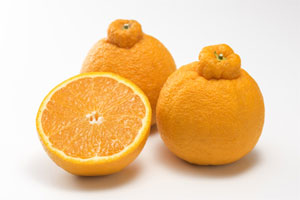

Japan’s Citrus Fruits: Bursting with Flavour
|
Ever wondered about the many kinds of citrus fruits from Japan? In fact, there are hundreds of citrus varieties in Japan! The very first mentions of citrus fruits can be found in the ancient texts of Kojiki (712 AD) and Nihon Shoki (720 AD). Based on these texts, we learn that a citrus fruit was brought back from China to Japan as a fruit which grants longevity. It is also thought that this oldest known Japanese citrus fruit is the “tachibana”, which is believed to be the progenitor of mikan found today in Japan. Since then, Japanese citrus fruits have developed in a variety of sizes, shapes and tastes, especially due to the range of climates of four seasons across Japan. Even within a single variety, there may be several sub-varieties. Let us take a look at some of them.
The satsuma orange, or unshu mikan, is the most familiar citrus fruit to Japanese, as it is sweet, seedless and easy to peel by hand. However, it was actually not a popular fruit during the Edo period, as seeds were associated with fertility and thus, the seedless satsuma was thought to bring an end to the family lineage. It only gained popularity during the Meiji period as it was easy to eat, and thus it was produced in great quantities. Interestingly, the flavour of satsuma changes depending on the time of harvest. Those harvested around fall have a stronger sour taste, while those harvested around winter are extremely sweet. During winter, it is common practice to enjoy satsuma while sitting in a kotatsu, a heater shaped liked a table and with a blanket. This is because satsuma keeps one hydrated while the body is warmed by the kotatsu. You can even find satsuma hotpots in Suo-Oshima town in Yamaguchi prefecture, in which whole satsuma fruits are boiled together with seafood. Yuzu is another popular Japanese citrus fruit, especially for its pleasant aroma and wide variety of uses besides yuzu juice or yuzu peel. It is used in yuzu-kosho (yuzu mixed with chilli peppers), which has a refreshing and spicy flavour, and is a popular condiment for sashimi, tempura and so on. Another well-loved seasoning is yuzu ponzu shoyu (yuzu in soy sauce base), which can be paired with boiled pork and blowfish sashimi. Moreover, one can enjoy hot baths in winter with fragrant yuzu fruits floating in the tub. The saying goes that you will not catch a cold all year round if you take such a bath. In fact, yuzu baths are known to help promote blood circulation, retain moisture in the skin and prevent ageing. You may have even seen photos of capybaras enjoying yuzu baths in Japan too. Other varieties you may have heard of before include sudachi, kabosu, and iyokan. Japan, particularly Ehime prefecture, is always developing new varieties and cultivation methods. For example, dekopon, also known as ‘sumo citrus’, has a distinct appearance as if it has a huge belly button. It was actually created by the crossing of the kiyomi and ponkan varieties. Certainly, Japan is home to an abundant number of citrus fruit varieties, and we may see even more unique varieties in the future. |
 © Web Japan  © Web Japan  Satsuma hotpot © Web Japan  © photoAC  Dekopon © Web Japan |
Resources
|
“Japan’s Citrus Fruits Are Loved by Many for Their Refreshing Fragrance”. 2020. Web Japan. Accessed 13 December. https://web-japan.org/trends/11_food/jfd202010_japanese-citrus.html. “The diversity of Japanese citrus fruits, in season from fall to spring”. 2023. Ministry of Agriculture, Forestry and Fisheries. Accessed 13 December. https://japan-food.jetro.go.jp/en/feature/detail/219.html. “How Japan Creates New Citrus Fruit Flavors”. 2023. Ministry of Agriculture, Forestry and Fisheries. Accessed 13 December. https://artsandculture.google.com/story/how-japan-creates-new-citrus-fruit-flavors-ministry-of-agriculture-forestry-and-fisheries/pAXx4bS6DyuJLQ?hl=en . “Yuzu and Mikan: Citrus Fruits in Japan”. 2023. Gochiso History. Accessed 13 December. https://gochisohistory.com/yuzu_mikan/ . |
|
Japan Creative Centre 4 Nassim Road, Singapore 258372 +65 6737 0434 / jcc@sn.mofa.go.jp https://www.sg.emb-japan.go.jp/JCC/ Nearest parking at Orchard Hotel & Delphi Orchard |
 |